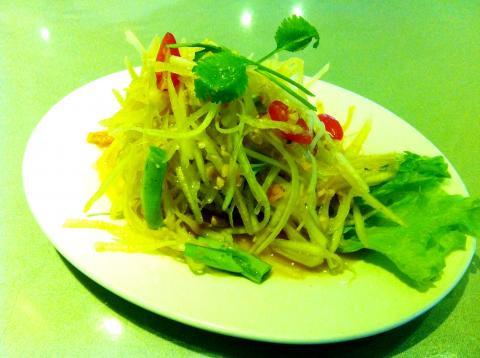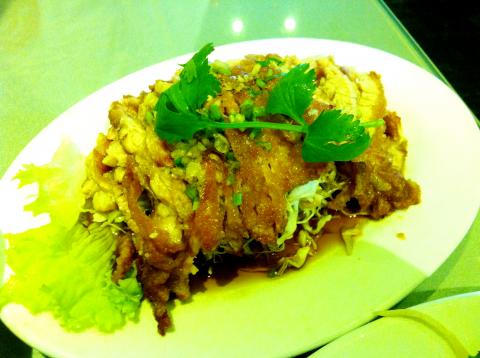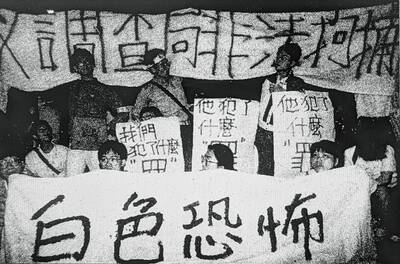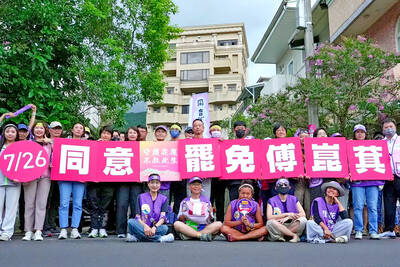It’s not the most authentic, nor is it ultra-chic, but A-gan Thai Theme restaurant serves up a reliable and satisfying family-style meal. Located near Wanfang Hospital (萬芳醫院), with a branch in Gongguan (公館), A-gan is one of a number of “Yunnan and Thai cuisine restaurants” (雲泰料理) that have sprouted up across the city in recent years.
A-gan calls itself a “NT$98 restaurant” (98料理), but in truth, only a dozen out of the 100 or so items on the menu actually cost that much. Most of the dishes at that price are stir-fried greens, which include standards like kongxincai with shrimp paste sauce (蝦醬空心菜).
Expect to pay between NT$120 to NT$200 for main courses like Thai-style curried shrimp (泰式咖哩草蝦, NT$180) or dapao zhurou (打拋豬肉, NT$120), which is ground pork stir-fried with basil, garlic, onion, lemongrass and slivers of chili. I love the beef version, dapao niurou (打拋牛肉, NT$150), which has a zesty flavor thanks to the lemongrass.

Photo: David Chen, Taipei Times
Another popular item is the steamed lemon fish (清蒸檸檬魚, NT$160). Its simple sauce makes this dish a winner: freshly squeezed lemon juice, a little broth and a generous amount of chopped garlic. Accompanied by two or three other dishes, the portions are just right for three or four people. Get a larger order for NT$320 if there’s more in your party.
A-gan’s pad Thai (泰式炒河粉, NT$110) can’t compare with what you can get at Thai Guo Xiao Guan (泰國小館) in Gongguan, one of the better places in the city for Thai food (see the Sept. 17, 2004, edition of the Taipei Times for a review), but it will do in a pinch. The pad Thai is a decent choice for a quick lunch or if you’re dining alone. The pineapple fried rice (鳳梨炒飯, NT$130) isn’t bad, either, though a tad too greasy.
The decor at A-gan wouldn’t stand out on Zhongxiao East Road (忠孝東路), but it’s relatively fancy for this part of town, located on a street full of budget restaurants and noodle shops that serve mostly students and hospital employees. The walls are painted in bold colors (mostly bright green and some orange) and the space is clean and comfy, with plush vinyl chairs and round tables for large parties. Diners will spot the restaurant’s Thai theme in the traditional metal drinking cups and rice pots.

Photo: David Chen, Taipei Times
A few other items worth mentioning include the green papaya salad (泰式涼拌木瓜, NT$98), which A-gan does very well, and jiaomaji (椒麻雞, NT$130), or crispy fried chicken served on a bed of raw cabbage and topped with cilantro, minced chili and a garlic and lemon vinaigrette.
Those sensitive to spicy foods will find A-gan accommodating. The top of restaurant’s order form has checkboxes for “very spicy” (大辣), “medium spicy” (中辣), a “little spicy” (小辣) or “not spicy” (不加辣). All menu items are available in larger portions for between NT$80 to NT$150 extra.
A-gan offers a decent deal for large groups, and the restaurant has plenty of space. The branch near Wanfang Hospital takes up two floors and seats around 80. The Taipei Times has yet to visit the Gongguan branch, but the restaurant informed us that it has 150 seats.

From the last quarter of 2001, research shows that real housing prices nearly tripled (before a 2012 law to enforce housing price registration, researchers tracked a few large real estate firms to estimate housing price behavior). Incomes have not kept pace, though this has not yet led to defaults. Instead, an increasing chunk of household income goes to mortgage payments. This suggests that even if incomes grow, the mortgage squeeze will still make voters feel like their paychecks won’t stretch to cover expenses. The housing price rises in the last two decades are now driving higher rents. The rental market

July 21 to July 27 If the “Taiwan Independence Association” (TIA) incident had happened four years earlier, it probably wouldn’t have caused much of an uproar. But the arrest of four young suspected independence activists in the early hours of May 9, 1991, sparked outrage, with many denouncing it as a return to the White Terror — a time when anyone could be detained for suspected seditious activity. Not only had martial law been lifted in 1987, just days earlier on May 1, the government had abolished the Temporary Provisions Effective During the Period of National Mobilization for Suppression of the Communist

When life gives you trees, make paper. That was one of the first thoughts to cross my mind as I explored what’s now called Chung Hsing Cultural and Creative Park (中興文化創意園區, CHCCP) in Yilan County’s Wujie Township (五結). Northeast Taiwan boasts an abundance of forest resources. Yilan County is home to both Taipingshan National Forest Recreation Area (太平山國家森林遊樂區) — by far the largest reserve of its kind in the country — and Makauy Ecological Park (馬告生態園區, see “Towering trees and a tranquil lake” in the May 13, 2022 edition of this newspaper). So it was inevitable that industrial-scale paper making would

Hualien lawmaker Fu Kun-chi (傅?萁) is the prime target of the recall campaigns. They want to bring him and everything he represents crashing down. This is an existential test for Fu and a critical symbolic test for the campaigners. It is also a crucial test for both the Chinese Nationalist Party (KMT) and a personal one for party Chairman Eric Chu (朱立倫). Why is Fu such a lightning rod? LOCAL LORD At the dawn of the 2020s, Fu, running as an independent candidate, beat incumbent Democratic Progressive Party (DPP) lawmaker Hsiao Bi-khim (蕭美琴) and a KMT candidate to return to the legislature representing